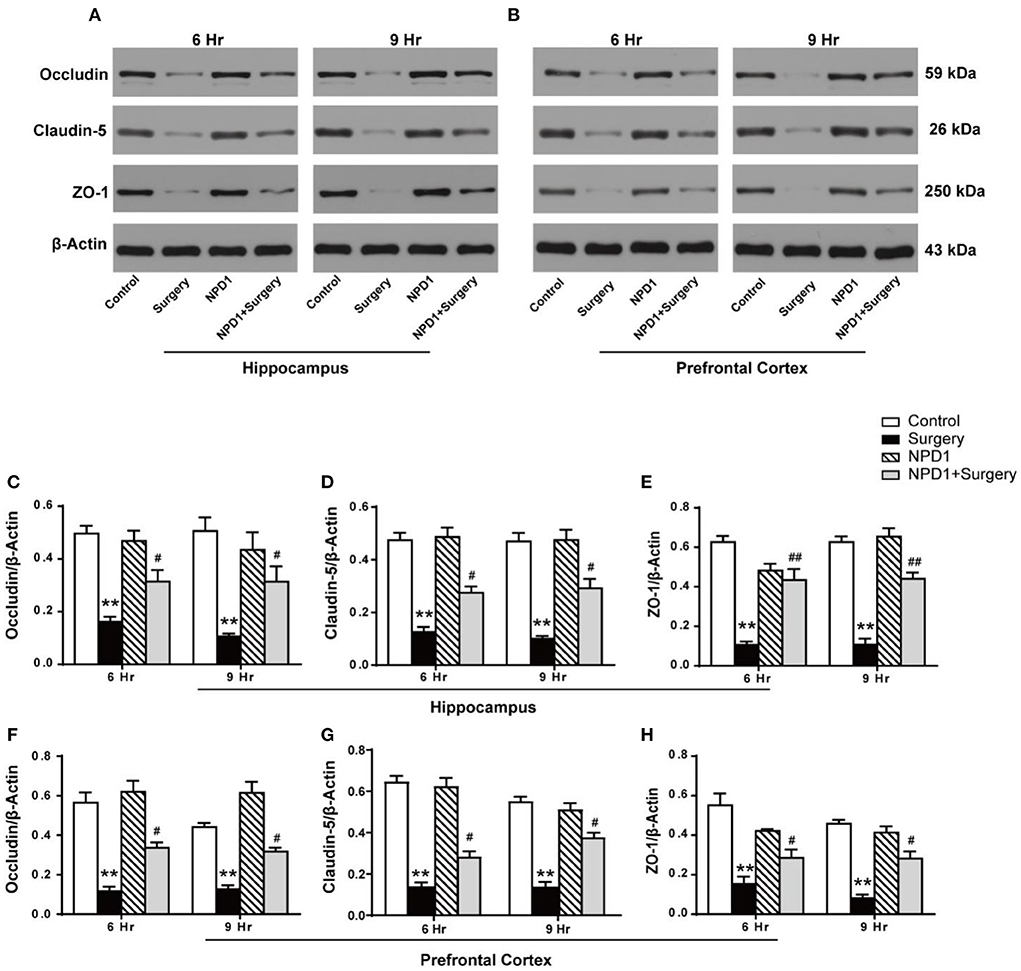A corrigendum on
Neuroprotectin D1 protects against postoperative delirium-like behavior in aged mice
by Zhou, Y., Wang, J., Li, X., Li, K., Chen, L., Zhang, Z., and Peng, M. (2020). Front. Aging Neurosci. 12:582674. doi: 10.3389/fnagi.2020.582674
In the original article, there was a mistake in Figure 4 as published. The bar graph for Claudin-5 protein expression (Figure 4G) incorrectly repeated the bar graph for Occludin expression (Figure 4F). The corrected Figure 4 appears below.

Figure 4. NPD1 modulates the expression of tight junction (TJ)-associated proteins in the hippocampus and prefrontal cortex after surgery. Representative Western blotting bands of the expression of occludin, claudin-5, and ZO-1 in the hippocampus and prefrontal cortex at 6 and 9 h after surgery (A,B). Quantification analyses of the expression of occludin, claudin-5, and ZO-1 were normalized to that of β-actin as internal control (C–H). Data are presented as mean ± SEM. Statistics: two-way ANOVA followed by Bonferroni post hoc comparison. (C–H) n = 4–5 per group. **P < 0.01 vs. the control group, #P < 0.05 vs. the surgery group, ##P < 0.01 vs. the surgery group.
The authors apologize for this error and state that this does not change the scientific conclusions of the article in any way. The original article has been updated.
Publisher's note
All claims expressed in this article are solely those of the authors and do not necessarily represent those of their affiliated organizations, or those of the publisher, the editors and the reviewers. Any product that may be evaluated in this article, or claim that may be made by its manufacturer, is not guaranteed or endorsed by the publisher.
Keywords: macrophage polarization, neuroinflammation, neuroprotectin D1, specialized proresolving lipid mediators, postoperative delirium
Citation: Zhou Y, Wang J, Li X, Li K, Chen L, Zhang Z and Peng M (2022) Corrigendum: Neuroprotectin D1 protects against postoperative delirium-like behavior in aged mice. Front. Aging Neurosci. 14:934855. doi: 10.3389/fnagi.2022.934855
Received: 03 May 2022; Accepted: 18 August 2022;
Published: 05 September 2022.
Edited by:
Yiying Zhang, Massachusetts General Hospital and Harvard Medical School, United StatesReviewed by:
Chen Chen, Indiana University Bloomington, United StatesCopyright © 2022 Zhou, Wang, Li, Li, Chen, Zhang and Peng. This is an open-access article distributed under the terms of the Creative Commons Attribution License (CC BY). The use, distribution or reproduction in other forums is permitted, provided the original author(s) and the copyright owner(s) are credited and that the original publication in this journal is cited, in accordance with accepted academic practice. No use, distribution or reproduction is permitted which does not comply with these terms.
*Correspondence: Mian Peng, c29waGllX3BtQG1zbi5jb20=
 Ying Zhou
Ying Zhou Zongze Zhang
Zongze Zhang Mian Peng
Mian Peng